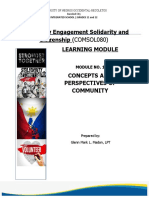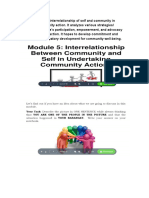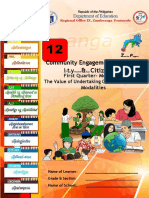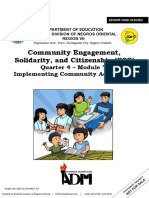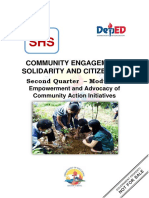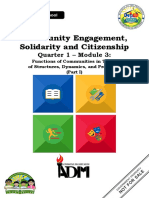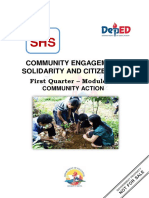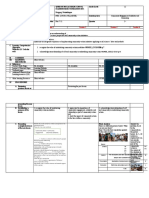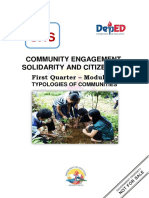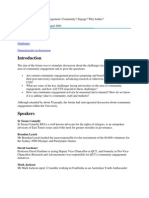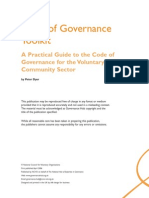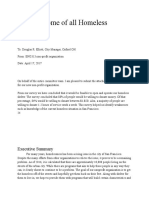www.shsph.blogspot.
com
SHS
COMMUNITY ENGAGEMENT,
SOLIDARITY AND CITIZENSHIP
First Quarter – Module 5b:
SELF-INVOLVEMENT IN
COMMUNITY ACTION
i
�www.shsph.blogspot.com
Community Engagement, Solidarity and Citizenship
Quarter 1 – Module 5b: Self-Involvement in Community Action
Republic Act 8293, section 176 states that: No copyright shall subsist in any
work of the Government of the Philippines. However, prior approval of the government
agency or office wherein the work is created shall be necessary for exploitation of such
work for profit. Such agency or office may, among other things, impose as a condition
the payment of royalties.
Borrowed materials (i.e., songs, stories, poems, pictures, photos, brand names,
trademarks, etc.) included in this book are owned by their respective copyright holders.
Every effort has been exerted to locate and seek permission to use these materials
from their respective copyright owners. The publisher and authors do not represent
nor claim ownership over them.
Regional Director: Gilbert Sadsad
Assistant Regional Director: Jessie L. Amin
Development Team of the Module
Writer: Miguel Angelo D. Dioquino
Evaluator: Katherine G. Frivaldo
Editor: Divina M. Diaz, Ph.D.
Jason G. Dogillo
Illustrator:
Layout Artist: John Paul D. Figueras
ii
�www.shsph.blogspot.com
INTRODUCTION
It is important to understand the relationship between the self and the
community. Every person feels that he or she is dependent upon the community. The
success of community action lies in the involvement of a person to his or her social
environment. As a student, you do not only live on your own but also you have moral
obligation to fulfill in the community process. This brings us to the classic saying that
no man can live as an island.
In this second lesson, you will explore the significant connections between your
self and the community. Your role as an individual can bring change to others through
active participation in the community process. This is why the lesson will guide you to
the possible roles and involvement you can have in undertaking community activities.
LEARNING OBJECTIVES:
By the end of this lesson, you will be able to:
1. acknowledge interrelationship of self and community in undertaking community
action;
2. analyze the roles of self in community action; and
3. evaluate a photo and write an insight in involving self to the community.
1
�www.shsph.blogspot.com
VOCABULARY LIST
Before you start your learning adventure, please be
familiar with the following terms that would be essential in
understanding our discussions:
Self. In this module, it refers to the individual person as part of a community.
Role. It refers to the function assumed by the individual in community action.
Interrelationship. The way in which each two or more things is related to the other
or others.
PRETEST
Now, please do the task below. This activity will give you an
overview of what you will learn as you go along the way to this module. Make sure to
finish this task. Good Luck!
Multiple Choice. Choose the correct answer.
1. It refers to the basic expression of human relationship where people see the need
to participate in their societies and to feel that they matter to others.
a. Volunteerism b. Unity c. Citizenship d. Community Action
2. Which of the following shows an interrelationship of self and the community?
a. An individual who does not have regard for community activities.
b. A pessimistic attitude because people are always too busy to get involved
in the community.
c. People rely in the government and private institutions’ effort to help
resolve community problem.
2
�www.shsph.blogspot.com
d. An individual who understands the situation of the community and has the
urgency to participate.
3. Which of the following situations best describe how to involve people affected by
the problem in the community?
a. Listen to them carefully so that you have a better understanding of the
causes of the problem.
b. Disregard their opinion about the crisis encountered by the community
since you have the expertise to resolve their community problem.
c. Pushing to implement a project even without the consent of the majority.
d. Conducting meetings and events that occupy the community members
work hours.
4. Why is there a need to involve ourselves with community action?
a. So that people would praise us with our program initiatives and
accomplishments.
b. We are part of a community which directly experiencing the problem and
we have civic obligation to be involved.
c. The community requires us to participate and there is no room for us to
disobey.
d. To build our credibility in organizing community actions.
5. Which of the following does NOT show possible roles of self-involvement in the
community?
a. Attending barangay hearing on solid waste management.
b. Conducting feasibility study on the possible program intervention in
impoverished community.
3
�www.shsph.blogspot.com
c. Being reactive to the initiative of outreach programs conducted by the
different school’s organization.
d. Taking the lead in community partnership.
Were you able to identify the correct answers?
Score:
3 - 5-Amazing! You were able to find the clues!
2 - below- It’s okay! Just focus in our discussions and pay attention to those
terms.
Now, I think you are ready to unveil our learning paths!
ACTIVITY 1
Photo Analysis
There are different pictures below. What can you say about
them? Describe their similarities guided by the rubric below.
Jurgenne H. Primavera, “The Mangrove
Katerina Francisco, “No hungry child: Malabon’s
Ecosystem,” ScienceDirect, 2019
feeding program aims to fight malnutrition,”
https://www.sciencedirect.com/topics/ea
Rappler, September 14, 2017.
rth-and-planetary-sciences/community-
https://www.rappler.com/move-
participation
ph/issues/hunger/182026-malabon-feeding-
program-fight-malnutrition
4
�www.shsph.blogspot.com
Tania Branigan and Kate Hodal, “Typhoon Haiyan:
frustration at slow pace of relief effort,” The Guardian,
November 15, 2013.
https://www.theguardian.com/world/2013/nov/14/typhoo
n-haiyan-relief-effort-stalls-philippines
Rubric:
Criteria Description Points
Content The description used were accurate based on the 10
picture; analysis and explanation were substantial
Presentation Application of concepts were creatively conveyed 6
Conclusion Main ideas and analysis were effectively connected 4
Total 20
PROCESSING QUESTIONS:
1. What is the message being conveyed by the photos?
2. Did the actions of different people in the pictures affect you as an individual?
Why?
3. As a student, how can you show your active involvement in your community?
5
�www.shsph.blogspot.com
Were you able to answer the questions?
Score:
2 - 3- Amazing! You have a keen observation!
1 - It’s fine! Maybe you need some time to go over the pictures, or you
may just focus your attention to the following discussions.
We have discussed in the previous topic about the
meaning of community action and its importance in the
development of society. We have also tackled that for
community action to happen, we have to recognize the notion of community
engagement, solidarity, and our civic obligations as citizens.
To further understand community action, there is an interrelationship of our self
and community. Our self and the community have connections which cannot be
separated. Am I willing to engage myself in the community? Do all my community
members agree on certain actions we would like to implement in the community? Who
will benefit if we work together? These are important questions when we intend to work
for community action. As an individual, we are always connected and tied up to our
community. We tend to make actions not just individually but collectively to respond to
the problem we encounter. Community problems are problems that concern a large
number of people. In other words, if there is a problem affecting the community, we
are the ones directly experiencing the problem. We create and make solutions instead
of being silent about it. Similar with the photos above, we can see that a group of
individual take actions in order to resolve an issue. They come up with immediate
solutions such as tree planting, feeding program and relief operations depending upon
6
�www.shsph.blogspot.com
the needs of the community. We involve ourselves as an individual through engaging
in the community and be a part of the solution.
However, in trying to engage in the community, it is important for you to understand
yourself first because you are continually influencing and shaping the process of
helping those most affected by a problem. Ask yourself:
What motivates me?
Why am I participating?
What do I want to achieve?
How will I react to different people and situations?
How committed am I?
How much am I willing to do?
If these questions are clear to you, then you have no worries to get yourself
involve in the big picture of community engagement. As discussed previously, it is
essential to note the value of solidarity in undertaking community action. It is the one
that will unify your interest to help with what the community wants to attain. For
example, a barangay wanted to end malnutrition rate among children. Our interest to
help the barangay to end malnutrition rate is not only the concern of few people but of
a large number of constituents. We have to unite people affected by the problem to
get involved in making solutions. This enable to fasten the implementation of
intervention projects to malnutrition problem and see its impact. Hence, solidarity
creates an environment in which mutual service is encouraged.
To show solidarity in the community, here are some of the roles you can have to
involve yourself:
7
�www.shsph.blogspot.com
Get involved in planning processes like creating goals or defining the problem.
Donate money or help out with a fundraising effort.
Volunteer to staff the office, answer phones, put together mass mailings, or
make phone calls.
Doing research, writing grant proposals, or handling correspondence.
Attend public events like community hearings, or fundraising events.
Serve on committees that focus on specific problems or activities.
Take leadership roles in a community partnership.
Involving yourself to community action can be complex. Every community is
different, with diverse social and cultural backgrounds. This brings you to a challenging
task on how to involve more people to participate in community engagement aside
from ourselves. There are two important ways to involve people affected by a problem
in helping them to be aware and solve the problem. First, you can listen to them so
that you have a better understanding about the causes of the problem. Second, they
can become involved through participation in the program initiatives that are being
developed by empowering them to tackle the problems they confront.
The spirit of volunteerism is also an important aspect that you have to consider
to engage in the community. Volunteerism is a basic expression of human
relationships. It is about people’s need to participate in their societies and to feel that
they matter to others. Volunteers have come to the forefront in helping with natural
disasters, advancing human rights, and touching lives to eliminate poverty and
improve basic health and education.
8
�www.shsph.blogspot.com
We all need to serve our community. Although you may initially see doing
service as restrictive or as a sacrifice, the reality is that it is liberating and fulfilling. You
become part of something bigger and better; creating an environment in which the
members can be successful.
Hi! You are done with the second part of the module!
Did you understand the relationship of self and
community in undertaking community action? Are the
roles clear to you regarding your involvement in
community action? If there are no clarifications, then
you will proceed to the practice tasks below.
PRACTICE TASK 1
Identify the problem faced by the community in the picture below. In 5 – 10
sentences, explain how can you involve yourself to be part of the community action in
the context of the situation in the picture. Use the rubric below in developing your
answers.
Kiana Gualberto, “Five years after Typhoon Haiyan” Unicef, November 8,
2018. https://www.unicef.org/philippines/stories/five-years-after-typhoon-
haiyan
9
�www.shsph.blogspot.com
Rubric:
Criteria Description Points
Content The description used were accurate based on the 10
picture; analysis and explanation were substantial
Presentation Application of concepts were creatively conveyed 6
Conclusion Main ideas and analysis were effectively connected 4
Total 20
PRACTICE TASK 2
Identify at least one possible role wherein you can participate in the following
community activities:
A. Barangay Health and Sanitation Program:
___________________________________________________________
B. Sangguniang Kabataan Election:
___________________________________________________________
C. Barangay Sports Clinic:
___________________________________________________________
Rubric:
Criteria Description Points
Organization The concept was clearly and creatively conveyed 6
Content The identified roles in different community activities 10
were thoroughly explained and examples were
provided.
Presentation The idea was clearly presented based on the words 4
used.
Total 20
10
�www.shsph.blogspot.com
PRACTICE TASK 3
Quotation Interpretation
In 3 sentences, explain the quotation “With Great Power Comes Great
Responsibility” given by Spider-Man. Relate it to your role and responsibility in
community action.
___________________________________________________________________
___________________________________________________________________
___________________________________________________________________
Rubric:
Criteria Description Points
Organization The interpretation was clearly and creatively 10
conveyed based on the quotes.
Content The application of content was connected to the 5
quotes.
Presentation The idea was clearly presented based on the words 5
used.
Total 20
Very good! You were able to finish the practice tasks! I think you are now
excited to answer the post test. Good luck!
POST TEST
A. Put a check (/) beside the number of the statement which
shows self-involvement in community activities and put an (x)
for the statement which do not show self-involvement in community activities.
11
�www.shsph.blogspot.com
_______ 1. A group of students conduct tutorial session as educational intervention to
non-reader students of Barangay San Roque.
_______ 2. Ana is hesitant to attend a two-day exposure in one of the indigenous
communities in Sorsogon due to her parent’s belief that this community is
unsafe.
_______3. In spite of hectic school activities, Mario volunteers to assist in the
barangay clean and green project during weekends.
_______ 4. A senior high school student believes that poverty is an endless cycle.
Thus, it is hard to break this social issue by just depending on the projects
of non-government organizations and private sectors.
_______5. Vanna explores to create network of funding partners in her initiative to
assist homeless families in her community.
B. Multiple Choice
1. Which of the following does NOT show possible roles of self-involvement in the
` community?
a. Attending barangay hearing on solid waste management.
b. Conducting feasibility study on the possible program intervention in
impoverished community.
c. Being reactive to the initiative of outreach programs conducted by the
different school’s organization.
d. Taking the lead in community partnership.
2. Which of the following situations best describe how to involve people affected by
the problem in the community?
a. Listen to them carefully so that you have a better understanding of the
causes of the problem.
12
�www.shsph.blogspot.com
b. Disregard their opinion about the crisis encountered by the community
since you have the expertise to resolve their community problem.
c. Pushing to implement a project even without the consent of the majority.
d. Conducting meetings and events that occupy the community members
work hours.
3. Which of the following shows an interrelationship of self and the community?
a. An individual who does not have regard for community activities.
b. A pessimistic attitude because people are always too busy to get involved
in the community.
c. People rely in the government and private institutions’ effort to help
resolve community problem.
d. An individual who understands the situation of the community and has the
urgency to participate.
4. Why is there a need to involve ourselves with community action?
a. So that people would praise us with our program initiatives and
accomplishments.
b. We are part of a community which directly experiencing the problem and
we have civic obligation to be involved.
c. The community requires us to participate and there is no room for us to
disobey.
d. To build our credibility in organizing community actions.
5. It refers to the basic expression of human relationship where people see the need
to participate in their societies and to feel that they matter to others.
a. Volunteerism b. Unity c. Citizenship d. Community Action
13
�www.shsph.blogspot.com
Score:
6 - 10- Well done! You have really learned our topic!
5 below - It’s fine. You may need some time to read the discussions once more.
You have reached your final task for this module. Just one more task and you
are done!
ASSIGNMENTS/ ADDITIONAL ACTIVITIES
Commitment Setting
Write at least 5 commitments on how you can involve yourself for the realization
of community action.
___________________________________________________________________
___________________________________________________________________
___________________________________________________________________
___________________________________________________________________
___________________________________________________________________
CONGRATULATIONS! You have successfully done the activities in this module. You
can now proceed to the next module.
14
�www.shsph.blogspot.com
ANSWER KEY
PRE-TEST
1. a
2. d
3. a
4. b
5. c
POST TEST
A. B.
1. / 1. c
2. x 2. a
3. / 3. d
4. x 4. b
5. / 5. a
15
�www.shsph.blogspot.com
REFERENCES
Padilla, Reynaldo A. Community Engagement Solidarity and Citizenship, JFS
Publishing Services, Manila Philippines 2016.
Moore Tim, Myfanwy McDonald, Harriet McHugh-Dillon and Sue West, “Community
Engagement: A Key Strategy for Improving Outcomes for Australian Families”
Child Family Community Australia Paper No. 39, April 2016.
Sirico, Robert A. “Solidarity: The Fundamental Social Virtue, Action Institute, Religion
and Liberty Volume 11, No. 5 July 2010.
Community Tool Box Section 7. Involving People Most Affected by the Problem 2016.
Retrieved June 15, 2020 from https://ctb.ku.edu/en/table-of-
contents/participation/encouraging-involvement/involve-those-affected/main
A Compendium of Daily Lesson Plans and Resource Materials in Community
Engagement, Solidarity and Citizenship, Department of Education, Region III,
2017. Retrieved June 15, 2020 from https://www.academia.edu/36784154/.
2_Community_ Engagement_Solidarity_and_Citizenship_CSC_Compendium
_of_DLPs_Class_F
Local Government Association, United Kingdom, Accessed June 15, 2020
https://www.local.gov.uk/our-support/guidance-and-resources/community-
action/community-action-overview/what-community-action
Tamayao, Michael John. Citizenship and Suffrage 2014. Retrieved from
https://tamayaosbc.wordpress.com/2014/08/02/citizenship-and-suffrage/
Stanford Encyclopedia of Philosophy, accessed June 15, 2020. https://plato.
stanford.edu/entries/citizenship/
Landao, Peter. What is a Stakeholder 2017. Accessed June 16, 2020
https://www.projectmanager.com/blog/what-is-a-stakeholder.
United Nation Volunteers 2019. accessed June 16, 2020 https://www.unv.org
/volunteerism/power-volunteerism
Primavera, Jurgenne H. “The Mangrove Ecosystem.” ScienceDirect, 2019
https://www.sciencedirect.com/topics/earth-and-planetary-
sciences/community-participation
16
�www.shsph.blogspot.com
Branigan, Tania and Hodal, Kate. “Typhoon Haiyan: frustration at slow pace of relief
effort.” The Guardian, November 15, 2013. https://www.theguardian.com
/world/2013/nov/14/typhoon-haiyan-relief-effort-stalls-philippines
Francisco, Katerina. “No hungry child: Malabon’s feeding program aims to fight
malnutrition” Rappler, September 14, 2017. https://www.rappler.com/move-
ph/issues/hunger/182026-malabon-feeding-program-fight-malnutrition
Gualberto, Kiana. “Five years after Typhoon Haiyan.” Unicef, November 8, 2018.
https://www.unicef.org/philippines/stories/five-years-after-typhoon-haiyan
Cover photo credit: Melody D. Legaspi (Rizal Integrated National School, Sorsogon City)
17













